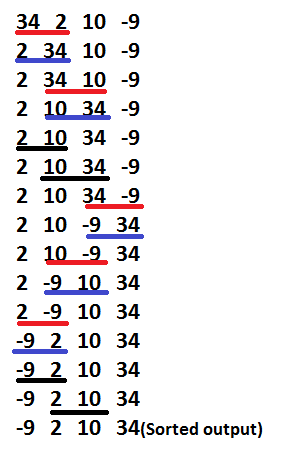Gnome Sort
Last Updated :
10 Jan, 2023
Gnome Sort also called Stupid sort is based on the concept of a Garden Gnome sorting his flower pots. A garden gnome sorts the flower pots by the following method-
- He looks at the flower pot next to him and the previous one; if they are in the right order he steps one pot forward, otherwise he swaps them and steps one pot backwards.
- If there is no previous pot (he is at the starting of the pot line), he steps forwards; if there is no pot next to him (he is at the end of the pot line), he is done.
Input –
Array- arr[]
Total elements – n
How gnome sort works?
Lets consider an example: arr[] = {34, 2, 10, -9}
- Underlined elements are the pair under consideration.
- “Red” colored are the pair which needs to be swapped.
- Result of the swapping is colored as “blue”

Algorithm Steps:
- If you are at the start of the array then go to the right element (from arr[0] to arr[1]).
- If the current array element is larger or equal to the previous array element then go one step right
if (arr[i] >= arr[i-1])
i++;
- If the current array element is smaller than the previous array element then swap these two elements and go one step backwards
if (arr[i] < arr[i-1])
{
swap(arr[i], arr[i-1]);
i–;
}
- Repeat steps 2) and 3) till ‘i’ reaches the end of the array (i.e- ‘n-1’)
- If the end of the array is reached then stop and the array is sorted.
Below is the implementation of the algorithm.
C++
#include <iostream>
using namespace std;
void gnomeSort(int arr[], int n)
{
int index = 0;
while (index < n) {
if (index == 0)
index++;
if (arr[index] >= arr[index - 1])
index++;
else {
swap(arr[index], arr[index - 1]);
index--;
}
}
return;
}
void printArray(int arr[], int n)
{
cout << "Sorted sequence after Gnome sort: ";
for (int i = 0; i < n; i++)
cout << arr[i] << " ";
cout << "\n";
}
int main()
{
int arr[] = { 34, 2, 10, -9 };
int n = sizeof(arr) / sizeof(arr[0]);
gnomeSort(arr, n);
printArray(arr, n);
return (0);
}
|
Java
import java.util.Arrays;
public class GFG {
static void gnomeSort(int arr[], int n)
{
int index = 0;
while (index < n) {
if (index == 0)
index++;
if (arr[index] >= arr[index - 1])
index++;
else {
int temp = 0;
temp = arr[index];
arr[index] = arr[index - 1];
arr[index - 1] = temp;
index--;
}
}
return;
}
public static void main(String[] args)
{
int arr[] = { 34, 2, 10, -9 };
gnomeSort(arr, arr.length);
System.out.print("Sorted sequence after applying Gnome sort: ");
System.out.println(Arrays.toString(arr));
}
}
|
Python
def gnomeSort( arr, n):
index = 0
while index < n:
if index == 0:
index = index + 1
if arr[index] >= arr[index - 1]:
index = index + 1
else:
arr[index], arr[index-1] = arr[index-1], arr[index]
index = index - 1
return arr
arr = [ 34, 2, 10, -9]
n = len(arr)
arr = gnomeSort(arr, n)
print "Sorted sequence after applying Gnome Sort :",
for i in arr:
print i,
|
C#
using System;
class GFG {
static void gnomeSort(int[] arr, int n)
{
int index = 0;
while (index < n)
{
if (index == 0)
index++;
if (arr[index] >= arr[index - 1])
index++;
else {
int temp = 0;
temp = arr[index];
arr[index] = arr[index - 1];
arr[index - 1] = temp;
index--;
}
}
return;
}
public static void Main()
{
int[] arr = { 34, 2, 10, -9 };
gnomeSort(arr, arr.Length);
Console.Write("Sorted sequence after applying Gnome sort: ");
for (int i = 0; i < arr.Length; i++)
Console.Write(arr[i] + " ");
}
}
|
PHP
<?php
function gnomeSort($arr, $n)
{
$index = 0;
while ($index < $n)
{
if ($index == 0)
$index++;
if ($arr[$index] >= $arr[$index - 1])
$index++;
else
{
$temp = 0;
$temp = $arr[$index];
$arr[$index] = $arr[$index - 1];
$arr[$index - 1] = $temp;
$index--;
}
}
echo "Sorted sequence ",
"after Gnome sort: ";
for ($i = 0; $i < $n; $i++)
echo $arr[$i] . " ";
echo "\n";
}
$arr = array(34, 2, 10, -9);
$n = count($arr);
gnomeSort($arr, $n);
?>
|
Javascript
<script>
function gnomeSort(arr, n)
{
let index = 0;
while (index < n) {
if (index == 0)
index++;
if (arr[index] >= arr[index - 1])
index++;
else {
let temp = 0;
temp = arr[index];
arr[index] = arr[index - 1];
arr[index - 1] = temp;
index--;
}
}
return;
}
let arr = [34, 2, 10, -9 ];
gnomeSort(arr, arr.length);
document.write("Sorted sequence after applying Gnome sort: ");
document.write(arr.toString());
</script>
|
Output
Sorted sequence after Gnome sort: -9 2 10 34
Time Complexity: As there are no nested loop (only one while) it may seem that this is a linear O(N) time algorithm. But the time complexity is O(N^2).
This is because:
- The variable – ‘index’ in our program doesn’t always gets incremented, it gets decremented too.
- However this sorting algorithm is adaptive and performs better if the array is already/partially sorted.
Auxiliary Space: This is an in-place algorithm. So O(1) auxiliary space is needed.
Like Article
Suggest improvement
Share your thoughts in the comments
Please Login to comment...